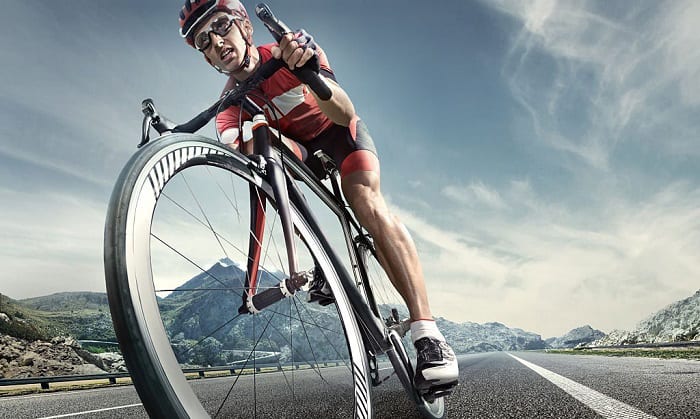Cycling is an enjoyable form of exercise that builds muscular structure and targets cardiovascular endurance. Cycling does not only aid in weight loss, but also tones and works several muscles on your body. It is a great way to put your body in shape.
But what muscles does cycling work? The primary muscles cycling targets are the lower body muscles, arms muscles, and the core. These are the muscle groups you can see noticeable improvement once you commit to cycling.
Table of Contents
Cycling Works What Muscles? – Primary Muscle Groups Used in Cycling
- Gluteus maximus
As you push down on the pedal, your gluteus Maximus or gluteus is heavily engaged. The gluteus maximus is the largest of the three gluteal muscles in your body. Once your hamstrings become overworked, it can add pressure on your lower back and knee. As a result, your glutes will also receive the pressure and get tone eventually.
- Hamstrings
Your hamstrings muscles usually run from your hips down the back of your legs and cross at the back of your knees. Hamstrings are very important in cycling because they enable the bending of your hips and knees while you pedal.
The hamstring muscles are most engaged when you move from a 6 o’clock to a 9 o’clock position. So, it is important to properly execute these positions to avoid tightness of the hip and knees. The common problems most cyclists encounter are hamstrings and knee issues.
- Quadriceps
When you constantly push the pedals down, you activate your quadriceps. Hence, having bulging calf muscles is very noticeable among cyclists.
- Calf muscles
When you hit your pedals with your toes, you can definitely build your calf muscles, too. The calf muscles sit in the back of your lower leg. It begins below the knee, then extends to your ankle. Calf muscles are heavily engaged when you run, jump, and cycle.
- Shin muscles
The shin muscles or the anterior tibial muscles are important in drawing the foot from an extended end at a 6 o’clock position going to a 9 o’clock pedal stroke. They are essential in walking and standing or even when executing vigorous activities.
The shin muscles are important in balancing your foot and toe mobility. It is one of the most active muscles when power pedaling.
Pedal Stroke – How Does It Work
What muscles does bike riding work? When you are in the 12 o’clock and 5 o’clock positions, the majority of your primary muscles are activated. You exhibit hip flexion where your hip and knee muscles receive pressure once you create a pedal stroke.
On the other hand, when you are in between the 6 o’clock and 12 o’clock positions, you will experience some knee flexion that benefits the muscles on your lower body part. With pedaling, it can target your hamstrings, calves, and quadriceps, too.
Once you power the pedal wherein your hip and knee extend to press a downward pedal, your gluteus and quadriceps muscles are activated. These muscles will be joined by the hamstrings and calf muscles every time you level up the pedaling.
Build Endurance and Strength
Endurance and strength are not only enhanced when you lift weights. Muscles biking works on your endurance and strength, too. To do this, you have to use the highest gear while riding. In this way, the components, specifically the gear of your bicycle will require more strength and power.
You can push yourself more, engage vital muscle groups, and tone them. You can add more stress to the activity if you bring a backpack or additional weight with you while cycling. Biking uphill can also develop strength and endurance in your core muscles.
Here are some of the things you can do to build endurance and strength in cycling:
- Squats
When you squat, you engage different muscle groups including glutes, hamstrings, and core muscles. The power phase on a bicycle is almost the same as the squat. Meaning, your glutes, hamstrings, and core are all engaged in the position.
- Single leg deadlifts
Every time you pedal, your one leg is working while the other one is at rest. It is similar when doing the single-leg deadlifts. When you work one leg at a time, you can correct muscle imbalances given that the leg should support the weight alone.
- Seated and standing biking
When you are in a seated biking position while traversing hills, your body experiences a huge amount of force, especially on the quadriceps area. Meanwhile, standing cycling is targeting your hamstrings muscles.
Both of these cycling positions should be done with a slower cadence and harder gearing. In this way, you can put more effort into the hamstring and quadriceps. The more effort you put in pedaling, the higher your chance of building strength and endurance in the legs.
Use of Speed
Speed is also crucial to tone your muscles while cycling. Faster cadence in a seated position will directly target hip flexors as well as the rectus femoris. The quadriceps muscles will be engaged when you lift the knee and foot up to a 12 o’clock position while pedaling.
When you increase the cadence, you can speed up the activation of your calf muscles. In this way, you can build better aerobic strength and develop efficient pedaling.
Interval training
Interval training is ideal if you want to lose fat and build muscles. With this kind of training, you alternate between difficult activities and easy ones. You can do interval training by engaging in a fast pace biking activity to a gradual and slow speed.
You can also do this by altering biking uphill and downhill. Regularly changing your cycling activity and intensity can help tone your muscles, too.
Use of Exercise Bikes and Elliptical Trainers
Another way to engage your major muscle groups and core is through exercise bike and elliptical training. This equipment enables you to control the speed and resistance of your activity. If you want to build your muscles fast, you can set a higher resistance training and increase the speed.
You can accompany this with an interval training. You have the option to slow down the speed and lower the resistance. Then, increase it again when you regain more strength and energy.
On the other note, we recommend doing this outside, so you can place more challenges and stress through your environment. Biking outside on hills can also provide higher resistance.
Conclusion
There are many benefits of riding a bike. Cycling is a perfect activity to work on your muscles. With biking, you can work on your lower body and core. Your glutes, hamstrings, shin, and quadriceps will instantly be activated and engaged.
If you regularly cycle to get in shape and tone your muscles, then you should be able to see significant results in the muscle groups we mentioned. However, you must commit and be consistent to observe faster results. You will be able to notice your progress once you notice that you find cycling easier.
Hope you find the answer to the question “what muscles does cycling work?”. Don’t hesitate to let me know if you have any questions. Thanks for reading!

“I ride my bike to work for years, but is that enough? Our carelessness towards our surroundings has taken a toll on the environment. And now, everyone is responsible for changes; even the most minor contribution is counted. With this hope and spirit, I started with my partner to establish Biketoworkday to help more individuals commute to their work sites on their bikes.”



